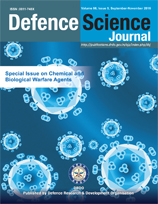Effect of Spacer and the Enzyme-Linked Immunosorbent Assay
DOI:
https://doi.org/10.14429/dsj.66.10700Keywords:
ELISA, lower detection limit, IC50, hydrphobic, hydrophilic, IMPAAbstract
The effect of spacers and the enzyme-linked immunosorbent assay (ELISA) formats on the functional parameters of assays such as lower detection limit, inhibitory concentration at 50 per cent (IC50), and specificity were studied. Enzyme conjugates having hydrophobic and hydrophilic spacers were prepared using O-isopropyl methylphosphonic acid (IMPA) and horseradish peroxidase (HRP) as an enzyme label. Comparison was made with reference to enzyme conjugate without any spacer. The present investigation revealed that the presence of a hydrophilic spacer in the enzyme conjugate significantly improves the sensitivity of assays. An enhanced IC50 value achieved was 0.01 μg mL−1 for free antigen detection by direct immunoassay using hydrophilic spacers and precoating of ELISA plates by secondary antibody. The use of a hydrophilic spacer might have helped in projecting the hapten in the aqueous phase, leading to enhanced antibody binding signal and improved sensitivity of the assay.Downloads
Published
2016-09-30
How to Cite
Sathe, M., Srivastava, S., Agrawal, S., & Ghorpade, R. (2016). Effect of Spacer and the Enzyme-Linked Immunosorbent Assay. Defence Science Journal, 66(5), 471–478. https://doi.org/10.14429/dsj.66.10700
Issue
Section
Special Issue Papers
License
 Where otherwise noted, the Articles on this site are licensed under Creative Commons License: CC Attribution-Noncommercial-No Derivative Works 2.5 India
Where otherwise noted, the Articles on this site are licensed under Creative Commons License: CC Attribution-Noncommercial-No Derivative Works 2.5 India


